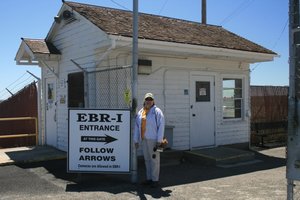Advertisement
Published: August 30th 2010

 You are here!
You are here!
After a drive across desolate Idaho desert, you finally arrive at the EBR-1 facility.The First Experimental Breeder Reactor, the EBR-1
Perhaps to start off with a story: Miners search for a hard to find mineral, a special kind of dirt. This special dirt is important because a small percentage of it is useable as a fuel to make energy in a special machine. The rare dirt and the small useable percentage make it difficult to make energy. Then someone devises another special machine that uses the small percentage of useable fuel dirt, makes energy and converts the unsuitable dirt into more fuel, more fuel than the machine needs to make energy. That is like putting ten gallons of gas in your auto, driving a hundred miles and then have fifteen gallons of gas remaining in your tank. Sounds crazy, but that is what a breeder reactor does, produce more fuel than it uses.
The first such experimental breeder reactor has been preserved, a National Historic Landmark, and is open to the public from the Memorial Day weekend to the Labor Day weekend. As well as being the first breeder, it also the first nuclear reactor to produce useable amounts of electricity. You will find the Experimental Breeder Reactor, the EBR-1, in the

 Period decor Entry
Period decor Entry
A charming note is the period furnishings in the greeting-waiting area. A modern monitor inside the TV cosole plays a tutorial video.desolate arid flatlands of Idaho, inside the boundaries of the Idaho National Laboratory. The nearby city of Arco boasts that it is the first city ever to be powered by nuclear energy. An easy drive from Idaho Falls, the EBR-1 waits to satisfy your curiosity about the nuclear age.
In this day and age, when nuclear power is common and nuclear reactors are busy producing electricity, it is a rare opportunity to see the inside workings of a nuclear reactor plant. The EBR-1 provides a unique look into nuclear energy. A self-guided tour allows the visitor to see inside and out, at your own pace, take all the pictures you want, and see virtually all of the reactor facility. From the auxiliary machinery, the reactor core, the turbines, the control room, it is all open for your inspection. There are no secrets here.
An Idaho National Laboratory website,
https://inlportal.inl.gov/portal/server.pt/community/community_outreach/265/ebr-1_tours,
gives historical information about the EBR-1 and driving directions. Check before going to check hours and dates open. The EBR-1 is closed during the winter months. A short side road off the public highway, US 20-26, allows access without elaborate security procedures.
The EBR-1 is more than sixty

 News! back then
News! back then
Copies of the Life Magazine that featured the EBR-1 back in 1951. A peaceful use for nuclear energy was welcome news.years old. The caretaker staff have preserved it so well that it looks like it was built just a few years ago. The clue to its age lies just inside the entrance. Period 50’s furniture, including a TV, coffee table with 1950 era issues of Life Magazine, set the stage for the story of the EBR-1. Born at the beginning of the nuclear age, it was a learning ground and the lessons learned used to build the newer and more efficient nuclear reactors that produce our electricity today and power ships of the US fleet.
The tour starts by going upstairs. There is a conference room with tables and chairs for where the engineers and scientists worked out the problems, developed the procedures, to make the breeder reactor a workable proposition. Chalk boards tell the story of nuclear fission in the simplest terms. The next stop is the control room.
The control room is like the back drop for an old sci-fi movie. All the meters and gages, control switches and recorders are period, mechanical equipment. There is nothing digital, nothing fancy. Walking about the control room one is reminded of just how complicated and difficult it is to

 Turbine, generator and light bulbs
Turbine, generator and light bulbs
The turbine and generator that produced the electricity from the reactors heat are on the balcony. The light bulbs recreate the first time generation of electricity from nuclear power.safely maintain a sustained nuclear reaction. All the functions, all the flow rates, coolant temperatures, neutron fluxes, they all have their measure and a perhaps several means to alter and control the values. You need a lot of eyes to watch everything all the time. Perhaps one of the more intriguing buttons is the SCRAM button.
An early concept, a single alarm that starts all the emergency procedure and directs the people to evacuate the containment building NOW! A single button serves for that purpose. If something goes wrong (I found this citation when researching the EBR-1. November Idaho Falls EBR-1, U.S.A. - The EBR-1 reactor had a partial core meltdown which destroyed it with ensuing low level contamination.) it was convenient for the engineer on duty at the main control panel. Push the button and run like hell!
You can stand on top of the actual reactor. A thick transparent cap lets you look into the heart of the reactor. The fuel rods have long since been removed, after it was decommissioned in 1964. There is no radiation hazard and the building and reactor are safe to visit and explore. It is almost as if you went back in

 Control Room 1
Control Room 1
A nuclear reactor is a simple machine but all of the needed control and monitoring systems make the entire machine a very complicated affair.time. For example, there is a valve in the piping for the coolant. A handwritten tag, left from when the reactor was decommissioned, tells us the setting is just right, calibrated in gallons per minute. Everything is pristine and I suspect that, were it necessary, the reactor could be refurbished, fueled and brought back on line it short order.
An interesting note is the coolant used inside the reactor. It is a mixture of two metals, sodium and potassium. The molten metal mixture is an efficient heat transfer mixture and does not interfere with the reactions inside the uranium fuel rods. Both sodium and potassium are solid metals at room temperature, they are highly reactive. Metallic sodium has to be store in a kerosene-like liquid to keep it separated from the oxygen in the air. It will ignite spontaneously if exposed to the air. The cooling system is a mechanical marvel considering the materials used and the conditions of operation.
The EBR-1 is credited as being the first reactor to produce useable amounts of electricity. However, its main function was to develop the procedure needed to validate and implement Enrico Fermi’s hypothesis, the breeder reactor. While the reactor was operating

 control Room 2
control Room 2
Radiation levels, primary and secondary coolant temperatures and flow rate, are but a few things constantly monitored and recorder on these chart recorders.it produced enough electricity to power the building. Many experiments required the reactor to be shut down and modified. During those times, the standby diesel powered generator or the steam boiler would be used to power the facility. That equipment is located in a bay just off the visitor greeting area.
The tour allows access to the basement level of the facility. Under the reactor’s core are the hot rooms where control rods were handled. The six-foot thick concrete walls and doors, thick green leaded glass and remote manipulators give evidence to the conditions inside. The radiation levels must have been the earthly equivalent of Hades. One chamber is open, you have to bend way over to walk in and watch your head, don’t hit it on the steel structures inside. Look around you and imagine what it must have been like when the reactor was operating.
Back then, when the EBR-1 was new, it was the cold war. The Strategic Air Command had bombers in the all the time to assure a response to a surprise attack from the Soviet Union. Engineers explored the possibility of using a small nuclear reactor to provide the heat needed tom

 Control Room 3
Control Room 3
The operator's control panel for the reactor. Look at the SCRAM button on the bottom right of the panel.operate a turbojet engine. The reasoning was that a nuclear powered aircraft could remain on airborne station for extended periods. That would reduce the need for constant aerial refueling of the airborne nuclear bomb carrying aircraft.
The crew would live and operate the aircraft from a shielded compartment at the front of the aircraft. The rest of the aircraft would be bathed in the escaping radiation from the reactor. After a duty tour of perhaps weeks, the crew would land the aircraft in a remote area. A specially shielded locomotive would tow the radioactive aircraft to a shielded hangar where the crew would be evacuated and the aircraft serviced by remote manipulators and shielded personnel, readying it for another duty stint.
The possibility was actually explored and test reactors were constructed. Way to large to actually be used in an aircraft, they were proof of concept engineering models. Two reactors and the shielded locomotive have been preserved and are displayed outside the EBR-1 building. Walk around the reactors. Follow the ducting and see if you can spot the two modified J-47 jet engines used in the project.
More than two thousand years ago the Greeks reasoned the

 Control Room 4
Control Room 4
Another chart recorder panel in the control room. It was important to keep track of all the operting conditions.existence of the atom. It would remain just a concept until the early eighteenth century when John Dalton proposed his theory about atoms, their weights and properties. Most of the concepts proposed by Dalton are valid today. In the early twentieth century the thoughts of atomic energy entered the thoughts of atomic scientists. Best summarized by Albert Einstein’s formula E=MC², the amount of energy released when matter is destroyed is tremendous. Spurred by the Second World War, nuclear research produced the first nuclear reactors and atomic bombs. Although there are still large arsenals of nuclear weapons, thankfully, the peaceful use of atomic energy has prevailed. I think atomic energy will continue to provide even larger percentages of our energy needs. The EBR-1 is worth a visit to see where much of the technology of today’s nuclear programs was developed. It is one of only two places where the public can see a nuclear reactor up close and personal. The other reactor is the preserved loading face of the graphite reactor in Oak Ridge, Tennessee. I think you will be delighted and amazed by the experience, all you see and learn.
Advertisement
Tot: 0.087s; Tpl: 0.013s; cc: 13; qc: 49; dbt: 0.0493s; 1; m:domysql w:travelblog (10.17.0.13); sld: 1;
; mem: 1.2mb






















Pat Knapp
non-member comment
Nuclear Reactor
Nice blog, very scientific with good descriptive dialog to inform the generic reader just what does happen.